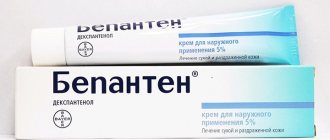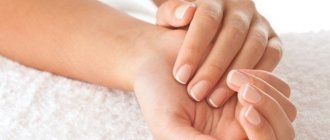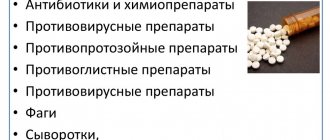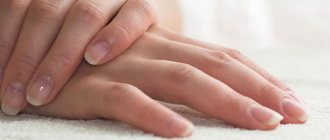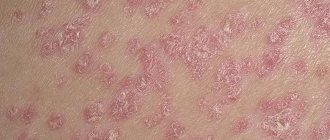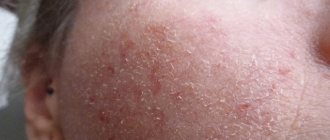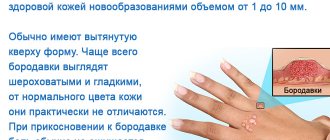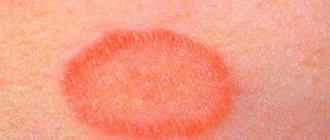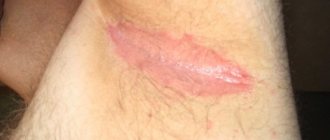Cold allergy: what is it?
People who are faced with the body's response to frosty air often ask: what is a cold allergy? By external signs, a cold allergy resembles damage to the body by a provoking factor, but in fact there is no allergen in such skin damage.
Dampness, frost and cold weather are factors that can trigger sensitization or sensitivity leading to cold allergies.
A person experiencing a cold allergy is interested in how to distinguish a reaction to cold, as well as how to treat its symptoms. First of all, before treatment, you need to know what a cold allergy is, its symptoms and how to recognize it.
A person who cares about health should know what cold allergies are, the symptoms and treatment of this unpleasant problem. Medicine did not recognize cold allergies for a long time, since there was no allergen in the cold form of skin allergy, but over time, research showed a different fact.
When a provoking source, that is, frost, is exposed to the body, a sharp release of histamine begins in it, leading to allergies. As a result, symptoms characteristic of cold allergies appear: swelling of the extremities, itching throughout the body and gradual dilation of blood vessels. This is the response of skin receptors to dampness and frost, where treatment is required.
Treatment methods
For the first and single attacks, it is recommended to take systemic antihistamines, preferably of the second and later generation - they do not cause drowsiness. The most effective drugs:
- Fenistil;
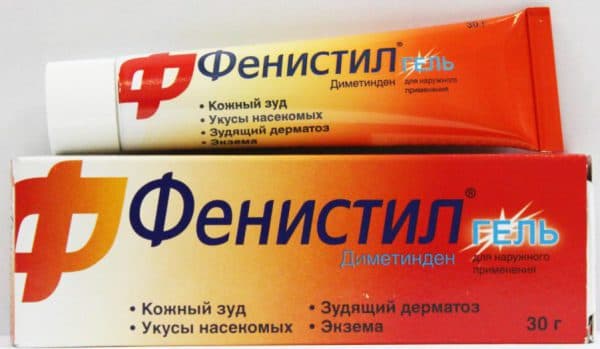
Excellent remedy for itchy hands - Zodak;
- Cetrin;
- Telfast.
If there are no such drugs, then you can limit yourself to simpler antihistamines, for example, Claritin, Suprastin and Tavegil. Before taking it, it is advisable to consult a specialist, since in some cases treatment is prescribed as a whole course. But what is the correct daily facial skin care and what products should be used first, is outlined here.
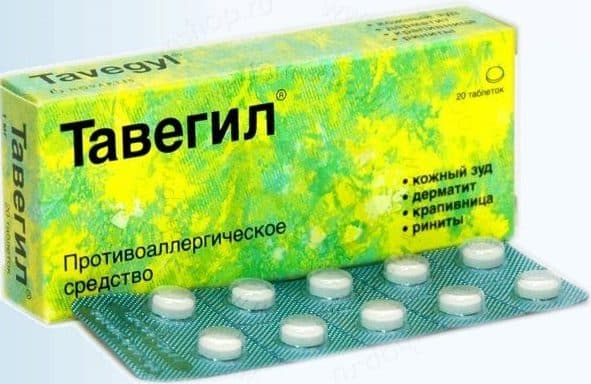
When using the product, it is best to consult a doctor
For regular manifestations of allergies to cold, treatment with hormonal drugs is recommended. For this purpose, both corticosteroids and glucocorticosteroids are used. Hormonal therapy can lead to various complications, therefore the course of treatment and dosage of drugs should be strictly limited.

The use of hormonal drugs is best prescribed by a doctor
The use of various pharmaceutical topical preparations in the form (various ointments, creams or gels) is not recommended, since they often cause complications and increase the risk of developing chronic dermatitis. You need to be especially careful when using topical products for children, since their skin is extremely sensitive to the effects of medications.
Folk remedies
Traditional medicine methods are ineffective for treating allergies. However, they can enhance the effect of traditional medications and can also be used for prevention.
If the body is hypersensitive to low temperatures, it is recommended to include red beets and sunflower seeds, which have a weak antihistamine effect, in the weekly diet. When swelling and hives appear on the hands after a cold, rub with birch or beet sap, as well as a decoction of celery root.
To prevent allergies in winter, it is recommended to take a decoction of dried raspberry or blueberry leaves at least twice a week. To combat excessive dry skin after frost, you can use compresses made from celandine, mint or burdock root. They can be easily purchased at any pharmacy. But what skin care products for teenagers should be used and how to choose them is indicated here.
Types of cold allergies
There are several types of cold allergies. Each type has its own symptoms and signs where treatment is required.
The first type is called a recurrent form of urticaria, in which allergies do not appear all year round, but only in certain seasons due to wind and low temperatures.
This may be autumn or early spring, when the body lacks vitamins and the immune system is weakened without treatment, then the cold type of allergy will not go away without therapy.
Acute or chronic form of cold urticaria. This form of cold subtype of allergy is the most dangerous compared to others, since when a reaction to frost occurs, the skin becomes covered with red spots, as if struck by nettles.
Itching begins throughout the body, which gradually spreads over the entire surface of the affected area of the skin, which indicates a cold allergic response.
In severe forms of the cold type of allergy, chills, pain in the joints and muscles, as well as a lethargic state may occur, and treatment is required.
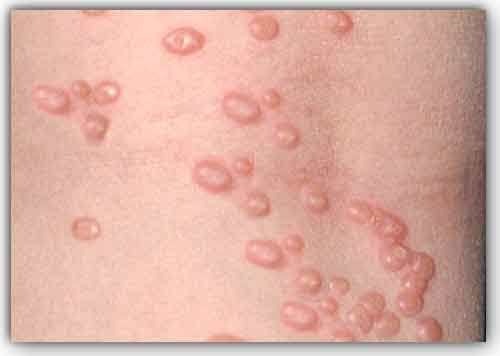
Blisters from frost
Allergy symptoms can last for several months until the end of winter, if timely treatment is not started, then a cold allergic response will manifest itself.
Familial cold urticaria appears as a hereditary form of allergy transmission. It causes itching and rash, accompanied by redness.
This form of cold allergy is extremely rare. Its distinctive features from other forms appear only 20-30 hours after being outside.
With reflex cold urticaria, a rash resembling hives appears around the cooled area of the skin, and the skin in contact with cold temperatures is only slightly affected.
With cold dermatitis, the skin becomes peeling, itches severely, and a rash appears.
If you have cold conjunctivitis, tears flow from the eyes and a burning sensation is felt, in such a situation treatment is needed. The cold type of allergy will not go away so easily.
There is another form - cold erythema. The affected area of the skin turns red, eczema appears, the redness resembles hives and hurts for several days if there is no treatment.

Types of cold allergies
Prevention
It is believed that it is impossible to completely get rid of allergies, but you can reduce the number of manifestations and the risk of rashes in the cold. You can prevent the occurrence of an allergic reaction by taking the following measures:
- when going outside in the cold season, you need to wear a hat and gloves, and also wear clothes appropriate for the weather;
- it is advisable to purchase clothes made from natural materials to ensure that the skin is enriched with oxygen;
- before going outside, you need to apply a rich moisturizer to the skin of your hands and face, which will provide reliable protection;
- if you are planning a long walk, it is advisable to take tea with you in a thermos to prevent hypothermia;
- it is important to systematically carry out hardening, as it strengthens the body’s immunity and resistance to cold;
- In autumn and winter, you should additionally take vitamins and biological supplements to strengthen the body's defenses.
- smear your hands with various moisturizing creams before going out. The most effective are hand creams with urea. Such products can be purchased at any store or pharmacy, and you can even make your own hand cream.
Various infectious and bacterial diseases can be a trigger for the development of allergies to cold. Any illness should be treated only under the guidance of a doctor, and promptly respond to the appearance of symptoms.
It is recommended to carry out hardening from a very young age, gradually increasing the duration and intensity of the procedure.
But this information will help you understand how to make your facial skin clean and smooth and what products to use first.
Causes of cold type allergies
In people who are sensitive to temperature changes and suffer from cold allergies, frosty air causes an effect on mast cells.
These cells are located on the surface of the skin. They give a signal, and a reaction occurs, accompanied by the release of histamine. The body, experiencing an excess of the above-mentioned hormone, responds with an allergic reaction.
People who are sensitive to weather changes should think about what the body’s reaction to a drop in ambient temperature is and what treatment is required.
There is a high probability that a disease is hidden in some part of the body, the development of which a person may not be aware of.
Eliminating the symptoms of a cold reaction is not enough. It is recommended to get rid of the root cause of the disease.
The main causes of cold-type allergies that can lead to complications are the following factors:
- chronic pathologies that a person has suffered from for a long time: sinusitis, sinusitis, caries or tonsillitis,
- disruptions in the functioning of the endocrine system,
- weakening of the immune system is often provoked by the presence of helminths in the human body,
- kidney pathologies, diseases of the gastrointestinal tract, liver and other organs,
- colds, stress and cancer,
- hereditary predisposition,
- infectious diseases, which include: chickenpox, mumps and pneumonia,
- existing problems with an allergic reaction to external irritants: dust, animal hair or pollen,
- long-term use of medications belonging to the category of antibiotics.
Rarely, there are precedents in which the above-mentioned type of allergic cold reaction is genetically predisposed. Intolerance to the cold form of allergy sometimes manifests itself in children if one of the parents had similar problems.
The most common type of cold allergy does not occur from cold, but is provoked by windy weather. Its main symptom is not itching, but burning of the skin.
Based on the above factors, it becomes clear that many people are at risk. Therefore, the possibility of acquiring a cold type of allergy cannot be ruled out. Such symptoms require treatment.
Predisposing factors for allergies are sometimes trivial changes in temperature conditions. For example, a person moves from one room to another or goes outside.
The release of histamine can be triggered by contact with supercooled water. This situation can occur when leaving the pool or while swimming in open water. Some people have trouble washing dirty dishes every day.
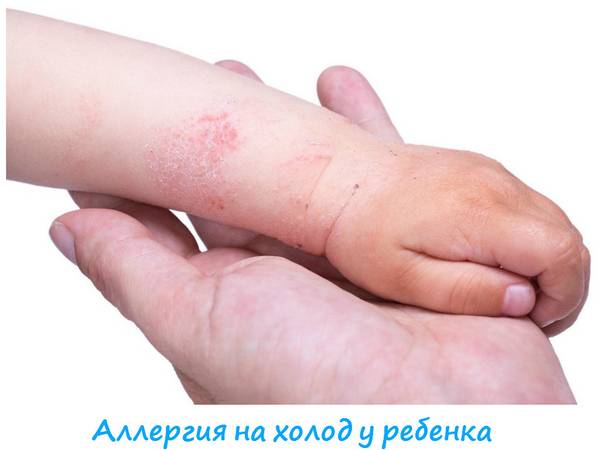
Main causes
Experts were able to find out that such an allergy is not a separate disease, it is only a symptom accompanying some other disease. The body can give such a response to cold due to weakening due to the long course of a latent disease.
Some experts argue that this allergy develops due to the production of criglobulins in the body, which causes the activation of histamine. The trigger mechanism can be triggered due to various factors: throat disease, decreased immunity, gynecological inflammation in women, parasitic diseases, colds, and infections. Various chronic illnesses can provoke cold allergies.
If an allergy to cold begins to appear in children, then this may be a continuation of a food allergy.
All attention should be paid to treating the underlying disease, and not getting rid of symptoms.
Symptoms of an allergy to cold
Returning from the street, people feel the symptoms of temperature changes. When returning from frosty air to warmth, parts of the body that were open to contact with street air turn red. This phenomenon is considered normal and does not cause much discomfort as it passes quickly.
Under normal conditions, this is explained by a rush of blood to the skin due to constricting blood vessels, which expand when warm and the skin becomes red. This phenomenon in adults and children disappears after 30-40 minutes. It doesn't need to be treated.
If we are talking about the symptoms of a cold allergy to frosty air, then it should be noted that its manifestations can come in various forms: in mild forms, a person experiences itching and swelling only upon direct contact with an external irritant, that is, on the street. Once he returns indoors, the cold symptoms disappear. This requires proper treatment.
Severe forms of the disease manifest themselves in redness and swelling of the skin, which last for several days and disappear only after treatment.
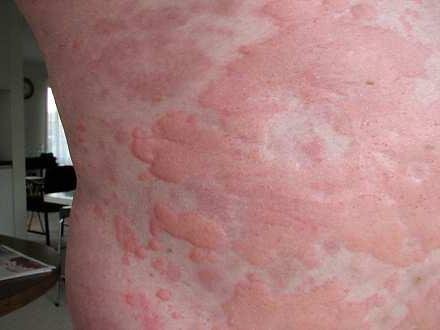
Cold allergy on the body
Most often, allergies occur in areas of the body that are not protected from air currents. This list can include the neck, arms, face, and also legs. These places are the most vulnerable because they often lack protective clothing against the cold.
In addition to allergies, some people experience allergic rhinitis from cold allergies, which makes it difficult to breathe. Breathing is difficult and accompanied by sneezing. After returning to the room, where the air temperature is close to optimal, the symptoms of a runny nose disappear.
Symptoms of cold allergies include the following:
- Presence of symptoms of tearing.
- Pain in the eye area and sensitivity in bright light.
- Swelling around the eyes and swelling of the eyelids are a clear symptom.
- Burning and itching of the skin, which manifests itself in peeling.
- Tears, sneezing and coughing.
- Chills and periodic headaches.
- Seals appearing on the surface of the skin, as well as blisters, which are an important symptom.
Due to the “established” symptoms, the allergic cold response to frost is sometimes called differently:
- cold rhinitis, which is associated with the occurrence of a runny nose and allergies in frosty air,
- cold conjunctivitis, which occurs in windy weather and produces excess discharge from the eyes,
- cold dermatitis, which occurs after visiting the street in wet weather, and its manifestations are peeling of the skin and damage to its surface, as well as red spots,
- cold asthma, which occurs as a reaction to fresh frosty air and is dangerous for suffocation in both adults and children,
- cold urticaria, which is characterized by skin rashes, as if injured by nettles.
Sometimes cold allergies are confused with infectious diseases, as well as ARVI. A distinctive feature of these diseases is the absence of fever. The cold type of allergy in adults and children is almost never accompanied by an increase in temperature, but treatment is necessary.
Swelling of the larynx and mucous membranes is noticeably different from that which can be observed during problems with infectious diseases.
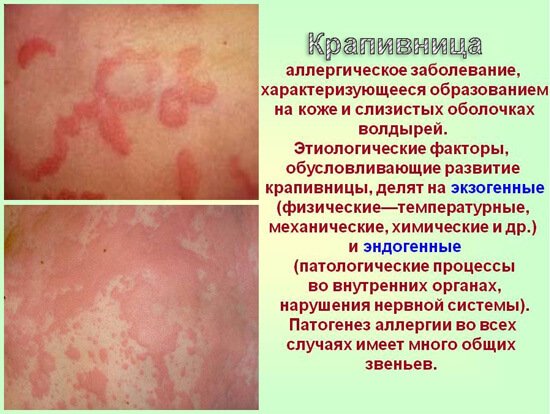
Allergic urticaria
Diagnosis of cold allergy
If a person has discovered the above symptoms and noticed a cold allergy on the hands and other skin of loved ones, then he should immediately visit an immunologist-allergist or therapist for treatment.
The cause of the allergic reaction and symptoms to changing weather will be determined through diagnostic and laboratory methods, and then treatment will be prescribed.
Cold allergies should be differentiated from other signs of disease by identifying symptoms, and the patient should be prescribed qualified treatment.
This disease is sometimes confused with ailments that have similar symptoms but different treatments:
- Atopic dermatitis is common in children, which has a number of symptoms, like a cold response and a sign when the skin itches and requires treatment,
- an allergy to perfume compositions that are applied to the area of the hands or neck can cause hyperemia and itching, so these types of allergies are easy to confuse; it is not classified as a cold allergy,
- intolerance to natural fur products, which often manifests itself in women when wearing a fur coat or coat made from natural ingredients, this requires treatment, but it is not of a cold type,
- idiopathic dermatosis is characterized by similar symptoms and these two types of disease, in many cases, can only be differentiated from cold by a medical specialist.
After a comprehensive examination, you need to diagnose the cause of the allergic reaction, symptoms and receive a competent treatment regimen.
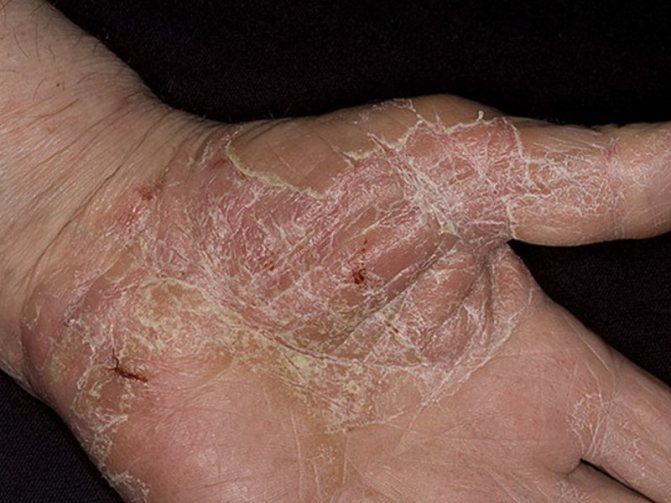
Manifestation of cold allergies on hands
Facial allergies in adults - causes
Allergic dermatitis on the face can occur due to many factors. The first symptoms, such as itching and rash, are rather abstract in nature and cannot indicate with absolute certainty the source of the reaction.
Therefore, if an allergy appears on the face, its causes are difficult to determine without appropriate research.
Food allergies
Food allergic dermatosis is most often triggered by protein foods.
The most common allergens:
Symptoms typically appear anywhere from a couple of minutes to two hours after eating the food. In severe cases, they can even appear from the smell of the product. With hypersensitivity to certain products, an allergy may appear on the cheeks in the form of swelling, itching and hives.
More dangerous consequences may include swelling of the mucous membrane, anaphylactic shock and loss of consciousness. The most effective treatment method in this case will be a complete abstinence from foods that cause an allergic reaction.
Contact allergy
This type of allergic dermatitis occurs when there is contact with an irritant that causes a response.
What can cause contact irritation:
- Plants - for example, allergic dermatosis may occur due to face cream if it contains herbs;
- Metals - the most allergenic are those found in stainless steel;
- Preservatives and stabilizers - found in cosmetic preparations;
The lesion manifests itself in young and middle ages and is much less common in children. Exposure to an allergen can manifest itself in facial redness, itching, flaking and dry skin; in more severe cases, fever, migraines and chills occur.
Allergy to physical impact
An allergic rash on the face can be caused by physical exposure, this could be:
- cold - cold allergies on the face usually look like hives and are accompanied by a runny nose.
- sunlight;
- pressure;
- Fever - Sensitivity to heat accompanied by increased sweating.
- water , etc.
Allergic rashes can appear not only as a rash, but also as red, itchy spots and blisters.
Allergy to insect bites
Angioedema and cheek allergies can be a symptom of increased sensitivity to insect bites. Once this type of allergic reaction occurs, it will most likely never go away. Its danger lies in the fact that it appears on the face not only in the form of dermatitis.
Insect poison and mica can cause Quincke's edema, which, in the absence of urgent measures, leads to rapid death from suffocation.
Symptoms of the disease:
- Local - occurs only at the site of the bite - burning, itching, pain, swelling, redness and thickening.
- Generalized - hives, runny nose, general weakness, difficulty breathing, fainting and low blood pressure.
Other reasons
- Environmental problems and air pollution can lead to an increased immune response to irritants.
- Hereditary pathology.
- Consumption of semi-finished products and exotic products previously unknown to the body.
- Frequent moving and adaptation to new climatic conditions, new infectious and nutritional environmental factors can force the immune system to work at its maximum and manifest itself in the form of dermatitis.
- Too careful use of hygiene products , which destroys the microflora of the dermis.
Treatment of allergies to cold
The main conditions in the treatment of cold allergies do not differ from the elimination of true allergies. First, it is important to treat the source of the cold allergy. In other words, for cold-type allergies, reduce contact with cold air and snow as much as possible, which will be the treatment.
Allergy sufferers who react to weather conditions are advised to wear clothing made from natural fabrics and not to walk in low temperatures, so as not to require treatment for a cold-type reaction.
The degree of cooling that can cause side effects on the skin varies from person to person. If for some people it is enough to be outside, where the temperature has dropped to -8 degrees and symptoms of a cold reaction appear, where treatment is required, then others experience an allergic reaction after contact with cold water and already need to take medicine.
If for some reason it was not possible to protect yourself from contact with low temperatures, symptoms appear, you need to take a shower and warm up, then the cold allergy will gradually go away without treatment.
There are medications to treat the symptom of reaction to cold air. Medicines used for this type of allergic reaction are as follows:
- Claritin,
- Suprastin,
- Tavegil.
In our country, you can purchase drugs for the treatment of cold allergies at the following prices:
| City | Claritin | Suprastin | Tavegil |
| Moscow | From 153 | From 133 | From 135 |
| Nizhny Novgorod | From 169 | From 100 | From 198 |
| Ekaterinburg | Cost from 160 rubles | Prices start from 98 rubles | Average price from 170 rub. |
Some antihistamines have a hypnotic effect and should not be used when performing work that requires high concentration. The ban on medications primarily applies to driving a car during the treatment period.
If the symptom of a cold allergy does not go away, then a special type of treatment is required; doctors prescribe glucocosteroids and immunosuppressants for the cold reaction.
In the presence of bronchospasms, bronchodilators are used to treat allergies to eliminate symptoms.
Attention! Before taking any drug for treatment, consultation with a medical specialist is required.
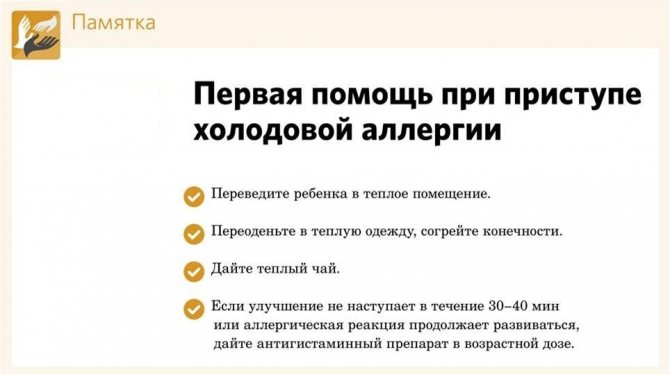
Treatment with folk remedies
Folk remedies in the treatment of cold allergies are of great importance and can be used at home to eliminate the symptoms of the body's cold reaction. They, along with drug therapy, can not only eliminate the symptoms of the disease, but also protect a person from such a reaction during further stay on the street.
Typically, for cold allergies, the following folk remedies are used to eliminate symptoms and treatment:
- Celery juice. This plant is taken in the form of juice for treatment and the symptoms of cold allergies will go away. The recommended dose is 0.5 teaspoon three times a day before meals and cold allergies will not occur on the hands and face, because the symptoms will disappear.
- Pounded blueberries. Blueberries should be thoroughly ground and applied to allergy-affected areas of the body against frosty weather to treat cold reactions and eliminate symptoms.
- Schisandra juice. If a person is bothered by burning and itching in the affected areas of the body due to cold allergic exposure, then after frost, returning to a warm room, the skin should be treated with lemongrass juice, which can eliminate these symptoms.
- Taking a pine needle bath. The needles are collected together with needles, and they are boiled at home. Then a bath with these branches is prepared for treatment. Allergy sufferers are advised not only to take a bath with these plants, but also to wash their faces during the day and evening so that cold allergies do not arise as a symptom.
- Birch sap for the treatment of swelling of the hands and feet due to the body's cold reaction. Drinking birch sap is useful not only for those people who want to treat cold allergies, but also for those who are concerned about their health. The recommended daily dose of this liquid is one liter. This remedy has a diuretic effect and can treat the symptom of swelling of the extremities in cold allergies. It is also an anti-inflammatory drink. To improve the taste, you need to add a little dried apricots or raisins, which helps relieve symptoms and treatment. There is no need to add sugar, as it is harmful to the body. Birch sap is not only a tasty folk remedy for treatment, but also a skin protector from harmful symptoms of many ailments, including cold allergies.
- Treatment with sunflower seeds and beet juice. These products can provide treatment against cold response symptoms and stop the disease through treatment. To treat cold-type allergies, seeds are consumed several times a week, and I drink beet juice half a glass a day for three times to relieve symptoms of cold-type allergies and eliminate symptoms.
- Infusion of pine shoots. If an allergic reaction is accompanied by dryness and the formation of small lesions on the skin, then it is recommended to use an infusion for treatment based on pine shoots, which can relieve the symptoms of cold-type allergies. Pine buds are infused with vegetable oil in a 1:1 ratio. The product must be infused for five months, after which it can be used for treatment. It is rubbed into the affected areas of the skin so that the cold reaction does not appear and the symptoms disappear.
- Raspberries. Raspberry roots can protect the body from cold allergies. To prepare the recipe, you need to have 50 grams of raspberry roots with you. Before treatment, they are poured with boiling water. Then simmer over low heat for 30-40 minutes. Next, the infusion should cool completely. The decoction should be consumed before going out into the cold, two tablespoons at a time, to prevent symptoms of a cold-type allergic reaction. Treatment with infusion begins two months before the onset of the winter season. If you use the decoction before the start of the winter season and the onset of cold allergy symptoms, then you can protect the body from irritation to the cold and cold allergies will not appear.
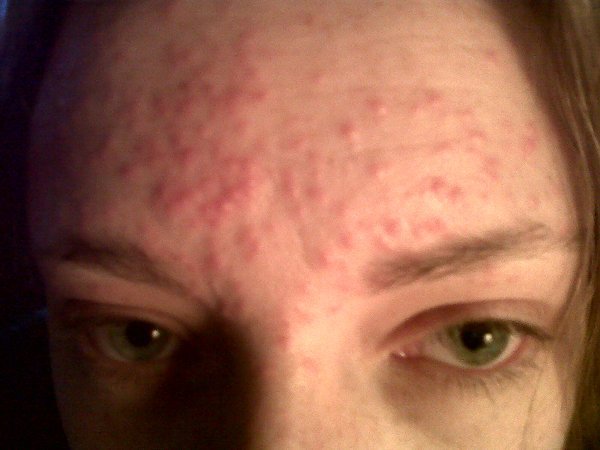
Cold allergy on the face
Treatment
It is worth noting that the treatment of cold allergies is similar to the treatment of ordinary allergies. To begin with, you need to have as little or no contact with the factor as possible, in this case with the cold. In winter, hypothermia should not be allowed; for this, it is best to purchase clothes made from natural fabrics. If you still cannot avoid the cold and hypothermia occurs, then you need to take a warm shower as soon as possible.
Symptoms can be relieved with various antihistamines. But you need to remember that they have a hypnotic effect, so you should not drive and do not do work that requires increased concentration.
This type of allergy occurs quite often in those people who have a chronic infection: pyelonephritis, bad teeth, cholecystitis, tonsillitis. First of all, it is necessary to get rid of these diseases.
Preventive recommendations
There are many recommendations regarding getting rid of cold allergies and its symptoms. People suffering from an allergic reaction should follow these guidelines to relieve symptoms:
- Clothes when leaving home should be sufficiently insulated. This rule must be used. It is important to ensure that your hands and feet are protected from drafts. Warm socks and gloves are faithful helpers in the fight against cold allergies. Clothing should be made from natural fabrics and not contain synthetic materials that can cause unpleasant symptoms. They negatively affect the condition of the skin, exacerbating existing allergy symptoms. Wool is also not recommended for use, since in its pure form this material can injure the skin and also cause allergies. A hood on the head will protect the body from the effects of frost and wind, thereby protecting against histamine release in the body.
- Chapstick should be used before going outside to avoid cold allergy. This will protect your lips from cold exposure. You should apply weather cream to your face, but not before going outside, but half an hour before. In case of a cold reaction, the face will be protected. There are also special ointments, but their use is agreed with a medical specialist when a person has a cold type of allergy.
- Before going outside, you need to drink a hot drink, but not an intoxicating one, since alcohol will negatively affect the condition of the skin and human health and will not eliminate the cold type of reaction.
- You need to breathe outside through your nose, not your mouth. Inhalation should be normal, but not deep, without tension.
- The diet also affects the body, so you need to monitor it and build it in accordance with the recommended standards for cold allergies. It is better to avoid fatty foods and replace them with fruits, vegetables and cooked foods. Oily fish, which contain omega-3, is allowed to be consumed.
- Badger fat is an effective remedy against cold allergies. It is able to enrich the body with beneficial vitamins and unsaturated fatty acids to combat cold allergies. Its effect on the body is manifested in strengthening the immune system. It is used forty minutes before leaving the house in the proportion of one spoon.
- A person with a weakened immune system should pay attention to the gradual hardening of his body. This must be done without much fanaticism. Ice and cold water are used after preliminary preparation. It is recommended to start hardening in the summer, and not in the winter season.
People who are seriously thinking about their treatment should notice the first manifestations of a cold allergy and consult a doctor in a timely manner.
You cannot turn a blind eye to obvious symptoms or ignore the cold reaction. This can lead to complications and serious consequences from cold allergies.

Allergy to cold on hands
How to get rid of allergies on the face?
The appearance of allergic symptoms can be easily eliminated by stopping contact with the original allergen. However, if this is not possible, medicines and folk remedies will come to the rescue. Remember that treatment can only be prescribed by a doctor, otherwise the situation can only worsen.
General principles of therapy include:
- Maintaining immunity;
- Blood cleansing;
- Antihistamines and symptom-relieving drugs.
Drug therapy
When treating allergies on the face, treatment is divided into 2 types:
- Etiopathogenetic - impact on the cause;
- Symptomatic - effect on symptoms.
The doctor decides how to treat allergic dermatosis on the face, based on its type.
Tablets for allergic dermatosis on the skin:
- Antihistamine tablets help in many cases, including even allergies to cold on the face.
- Tavegil - 180 - 250 rubles;
- Zyrtec - 200 - 390 rubles;
- Claritin - 230-250 rub.
- Sorbents are used for food allergic reactions, they treat its manifestations in the stomach and intestines, and after them the rashes on the face go away.
- Enterosgel - 390 - 470 rubles;
- Smecta - 150 - 410 rubles;
- Polysorb - 260 - 290 rub.
What to put on your face if you have allergies?
Ointments are used in conjunction with oral antihistamines. They complement treatment and promote rapid relief and relief of acute symptoms before important events or severe discomfort.
Non-hormonal ointments for allergies on the face
Facial skin allergies may require ongoing treatment; in this case, it is better to use non-hormonal medications - they are much safer. But even they should be used only after consulting a doctor.
- Fenistil is an antihistamine cream for allergies on the face, carefully used 2-4 times a day, price - 400 rubles.
- Psilo-Balm is an antihistamine, applied 3-4 times a day, helps well against allergic edema, price - 250 rubles.
- Radevit Active is a healing ointment for facial allergies in adults, rubbed in twice a day. If there is an open wound (cracks, severe scratching, etc.), the area should be pre-treated with an antiseptic. The duration of use is unlimited, the price is 370 rubles.
Hormonal ointments for allergies on the face
Hormonal creams for allergies on the skin of the face are considered the most effective and are used when other creams do not help. They influence the inflammatory process and slow down the process of cell destruction.
However, hormonal ointments for allergies on the face cannot be used for a long period and during infectious diseases, because they can suppress the immune system and have a systemic effect. Under no circumstances should you apply hormonal ointments without a prescription from an allergist.
- Hydrocortisone ointment - applied 2-3 times a day, should not be applied to steamed skin to reduce the penetration of the product into the blood. Price - 30-40 rubles.
- Elokom - used once a day, price - 200 - 360 rubles.
- Gistan - course duration - 1 - 4 weeks, has additional antipruritic and anti-inflammatory effects, should not be used during pregnancy, price - 170 rubles.
Therapy with folk remedies
In addition to the use of medications, the use of folk remedies is quite often practiced. Some recipes should not be used on particularly sensitive areas of the skin - near the eyes, lips, mucous membranes. Another thing is allergies on the chin, cheeks and other places where the skin is not so sensitive.
If after alternative therapy the condition worsens, treatment should be stopped immediately.
- Decoction recipes:
- The bay leaf is boiled in a small amount of water and left to cool. The decoction relieves itching and redness; it can be used to treat allergic spots on the face in children, and can be taken orally by adults.
- The herb against allergies on the face can also be taken orally and externally. The recipe is the same as the previous one and relieves even very severe itching.
- A collection of herbs for the treatment of facial allergies (rose hips, St. John's wort, centaury, dandelion root, corn silk and horsetail) can be found at the pharmacy or collected yourself. Place the herbs in a thermos, pour boiling water over them and leave for 7 hours, strain and take chilled orally.
- Horseradish cream for facial allergies. Mix a tablespoon of horseradish juice with the same amount of sour cream and leave for 1-2 days. Apply the cream to a clean face before going to bed no more than 2-3 times. The mixture helps cure allergies and acne.
- Mint ointment . Pour 2 tablespoons of dry mint with the same amount of boiling water, mix well and let cool. To get rid of an allergic reaction on the face, apply the ointment 1-2 times a day for 20 minutes. This folk remedy for facial allergies relieves itching, erythema and irritation. It can also be used if you are worried about allergies on your chin.
- Mustard ointment for facial allergies. Mix one tablespoon of mustard powder with just boiled water to a thick consistency. Apply to skin before bed. You should be careful with this recipe, sometimes it can only increase the itching on the face. It may be suitable for minor chin rashes in women.
Reasons for the development of the disease
Medicine cannot yet answer exactly why an allergic reaction to cold occurs. Provoking factors for diseases can be:
- a sharp change in being in different temperature conditions (leaving a warm room outside in frosty weather);
- contact with cold water;
- drinking cold liquid or food;
- the presence of other types of allergies (food allergies, hay fever);
- long-term antibiotic therapy;
- infectious diseases (measles, mumps, rubella);
- diseases of the gastrointestinal tract, thyroid gland;
- eczema, psoriasis;
- Giardiasis in children and others.
Sometimes cold allergies can be hereditary.
